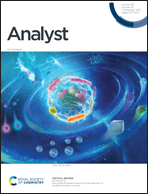Monitoring of n-hexane degradation in a plasma reactor by chemical ionization mass spectrometry†
Abstract
n-Hexane (C6H14) removal and conversion are investigated in a filamentary plasma generated by a pulsed high-voltage Dielectric Barrier Discharge (DBD) at atmospheric pressure and room temperature in a dry N2/O2 (20%) mixture with C6H14. The degradation of n-hexane and the by-product formation are analyzed in real-time using a high-resolution Fourier Transform Ion Cyclotron Resonance (FT-ICR) mass spectrometer coupled with Chemical Ionization (CI). As alkanes are reacting slowly with H3O+ ions, two precursor ions were used: O2+ to follow the n-hexane mixing ratios and H3O+ to follow the mixing ratios of organic by-products. As the CI-FTICR technique can work at high mixing ratios, studies were made between 5 and 200 ppm of n-hexane. Absorption spectroscopy is also used to follow ozone and carbon dioxide molecules. We show that the DBD efficiency increases for lower n-hexane mixing ratios and a large number of by-products are identified, with the major compounds being: formaldehyde, acetaldehyde, propanal, carbon dioxide, and carbon monoxide along with nitrate compounds. Based on the nature of the by-products characterized, a mechanism accounting for their formation is proposed.



 Please wait while we load your content...
Please wait while we load your content...